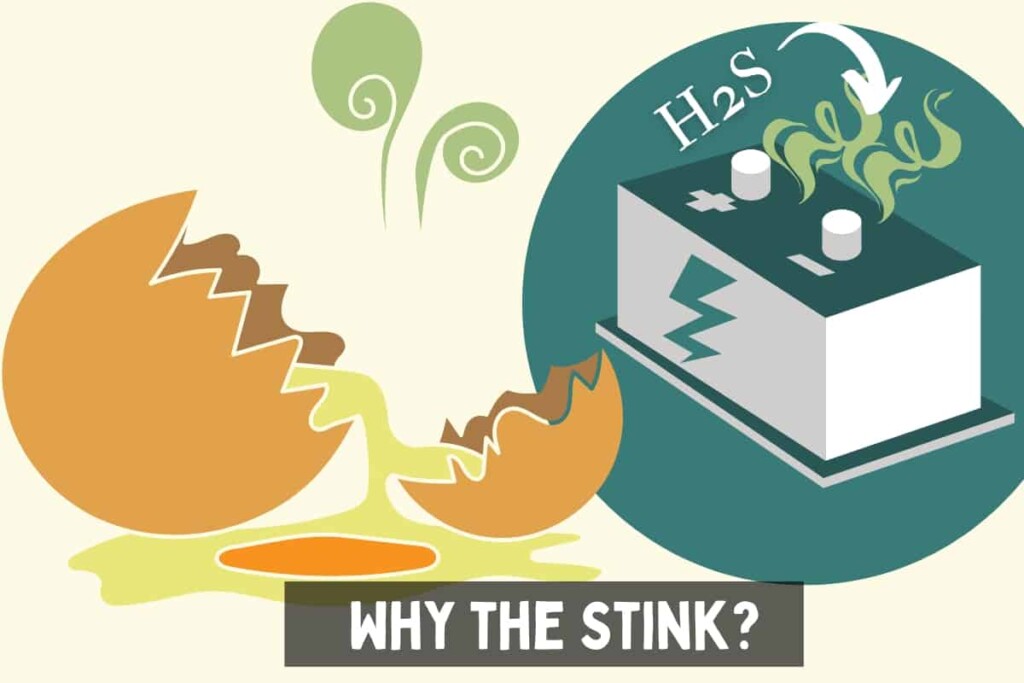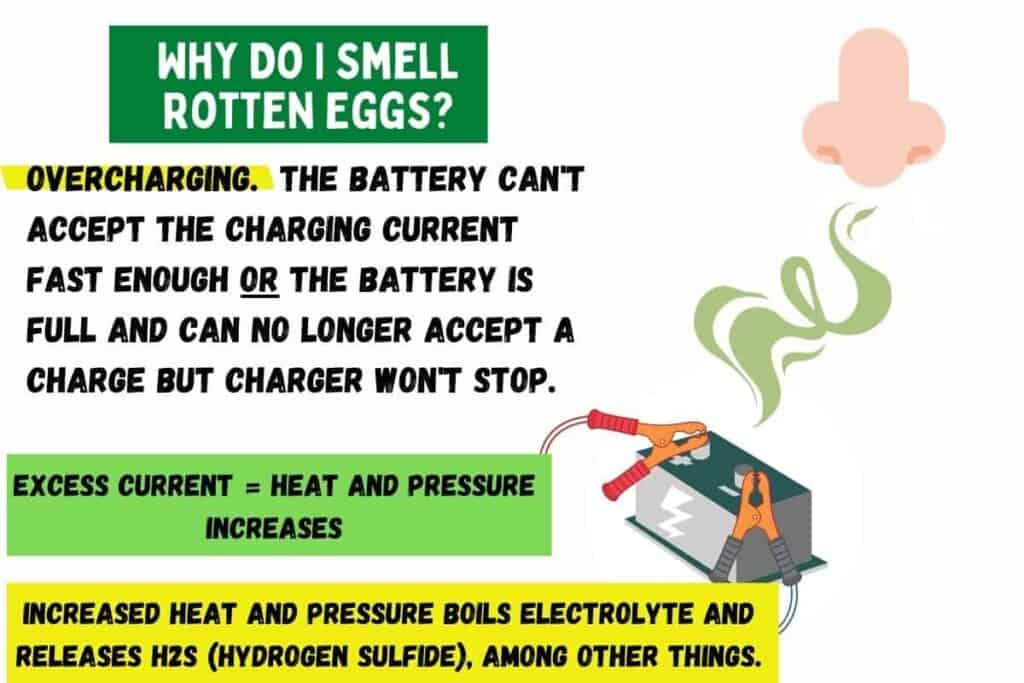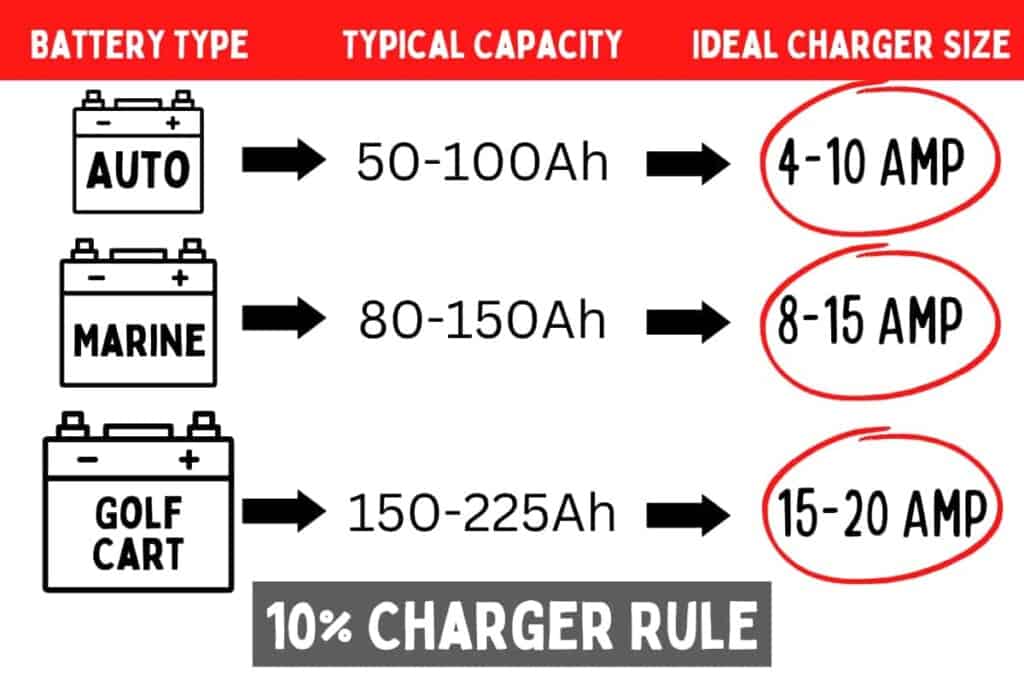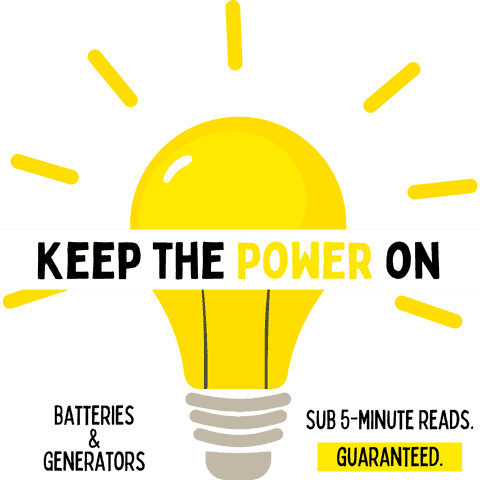If you’ve got a lead acid car, a marine, or golf cart battery, then you know that you’ll need to charge them from time to time. Some strange things can happen after you hook up a battery charger, and one of them is the potent smell of rotten eggs.
What is this smell and is it normal?
This article will stay high-level and get straight to the point. We’ll talk about what it is that you’re smelling, if it’s dangerous, and how to prevent it from happening in the future.

Why Does my Battery Smell Like Rotten Eggs when Charging?
The rotten egg smell that is hitting your nose is hydrogen sulfide (H₂S) (OSHA link). This is a noxious gas that is flammable and can be lethal if the concentrations are great enough. It is caused by a battery that is in a state of overcharging.
This can occur for one of many reasons, just to name a few:
- Charger is over-sized for the battery at hand (most common)
- Charger is running a “reconditioning”, “equalization”, or “desulfation” process (common depending on brand)
- The charger is defective (less common)
- A charger without a float/maintenance mode is left connected to the battery after it has reached 100% state of charge
- The battery’s cells are compromised (an internal short in one or more cell, for example)
The amps of the charger being used should not exceed 10% of the battery’s total amp-hour sticker rating (Ah). Car batteries typically have a 50-100Ah capacity, marine batteries are typically 80-150Ah, and golf cart batteries are 150-225Ah.
Therefore, appropriate battery charger sizes would be 5-10 amps, 8-15 amps, and 15-20 amps, respectively for the aforementioned categories.
A battery can only convert electrical energy into stored chemical energy at a given rate depending on its current state of charge at any particular moment. The more depleted a battery is, the faster and more efficiently it can make this conversion. As it charges, the efficiency and conversion rate slow down.
If your charger’s amperage exceeds what the battery can convert, then the battery will dissipate this excess in the form of heat as the unneeded electricity starts breaking apart the electrolyte on a molecular level in a process called hydrolysis.

Essentially, this means that your electrolyte will heat up and start to boil, which will result in the electrolyte evaporating out of the vents. These evaporated gasses escape more readily out of a flooded battery (one where you can pop the caps) than with a sealed battery which will recombine these gasses back into the electrolyte as long as the pressure doesn’t build too high.
Water molecules as well as hydrogen sulfide (H₂S) are expelled.
If you hook up a 30-amp charger to a car battery with 60Ah, you are well above the 10% rule of thumb and there is no way your battery will be able to convert all of this electrical energy into stored chemical energy fast enough.
Many modern chargers also have a “reconditioning”, “equalization”, or “desulfation” process which may happen automatically or may need to be manually toggled (my preferred method). This process is a “controlled overcharge” that is designed to agitate the electrolyte solution and dislodge any lead sulfate crystals that have started forming on the plates inside the battery which reduce its performance and capacity.
This process can take hours and it’s up to you if you want to perform it. It’s a much debated topic online, and you’re free to research it for yourself to make up your own mind.
Older chargers that do not have a float mode will continue to charge even after the battery has reached 100% state of charge. Leaving one connected will cause your battery to heat up and expel a savory rotten egg smell. Be careful and attentive of these chargers!
If your battery has a bad cell — one that is shorted out and cannot accept a charge, for example — then you could also experience this rotten egg smell if your charger doesn’t recognize that the battery is defective.
A 12-volt battery will have 6 individual cells inside whose individual voltages add up to 12.65+ volts when fully charged. A charger will try to bring a battery to this level. If one cell won’t accept a charge, the other 5 cells will be overcharged to compensate for the bad one. Most modern chargers will recognize a defective battery, but it’s still something to consider.
Is the Rotten Egg Smell Dangerous from My Battery?
Hydrogen sulfide, the rotten egg smell that’s hijacking your nostrils, is a noxious gas and can definitely lead to injury or death depending on concentrations and duration of exposure. Unless you’re in a sealed room with a battery that’s generating it, you’re probably not going to die but you could certainly be injured by it.
When a charger I was using conducted an automatic “desulfation” process (I no longer use this charger!) I was in the room with it for about 10 minutes trying to figure out what was happening since I wasn’t aware of this automatic feature. For several days afterward my throat and sinuses felt raw and I went “nose blind” to the smell after only a few minutes, so keep that phenomenon in mind.
According to the CDC, the following are common symptoms for acute exposure:
- nausea
- headaches
- delirium
- disturbed equilibrium
- tremors, convulsions
- skin and eye irritation
For a detailed breakdown of exposure times, concentration levels, and their effects on the human body, you can check out the CDC and OSHA data.
How Do I Stop my Battery from Smelling Like Rotten Eggs?
If your battery smells like rotten eggs, unplug the charger immediately unless you’re performing a desulfation process (but do so in a well ventilated area).
Verify that your battery charger is not over-sized for your battery. Remember to keep the charging amps at 10% or less of the battery’s total amp-hour sticker rating.

If your charger says “do not overcharge” battery, then it likely doesn’t have a float mode which keeps that battery right at 100% without overcharging. Remove the battery charger when the charging process is complete.
